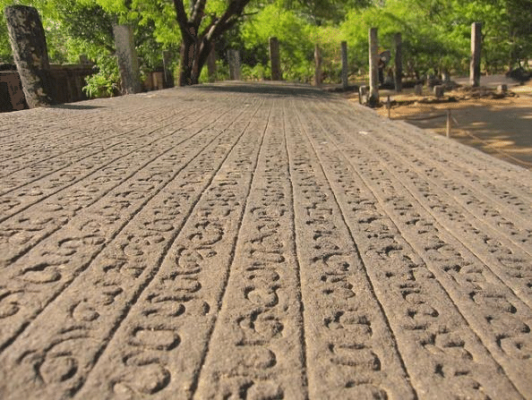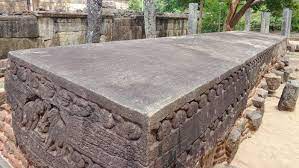Gal Potha (Stone Book) – inscription of yore
By Arundathie Abeysinghe

 Gal Potha (Stone Book), a renowned inscription describing tasks of King Nissanka Malla (1187-1196) of *Polonnaruwa Kingdom, considered as an inscription of self-appraisal (of King Nissanka Malla) is a massive slab 8.2 meters long (26 feet 10 inches) and 1.4 meters broad (4 feet 7 inches). Gal Potha is placed between the eastern outer wall of *Hetadage and *Sathmahal Prasada.
Gal Potha (Stone Book), a renowned inscription describing tasks of King Nissanka Malla (1187-1196) of *Polonnaruwa Kingdom, considered as an inscription of self-appraisal (of King Nissanka Malla) is a massive slab 8.2 meters long (26 feet 10 inches) and 1.4 meters broad (4 feet 7 inches). Gal Potha is placed between the eastern outer wall of *Hetadage and *Sathmahal Prasada.
The text in the Inscription is written in three columns and contains over 4300 characters in 72 rows. The letters of the inscription have been gilded with molten iron. The stone slab is an inscription about King Nissanka Malla, his rule, his heroic and altruistic deeds including his contribution to develop Polonnaruwa Kingdom as well as his eligibility for assuming the position of a king. Scholars are of the view that Gal Pota had been done during the ninth year of King Nissankamalla’s reign.
The Inscription, the longest inscription discovered in Sri Lanka is considered of immense historical and archaeological value. The Inscription is of immense value as it is a major source of information about the reign of King Nissankamalla. According to scholars, as the Inscription resembles an *ola leaf, it is known as “Gal Potha”. The writing on the Inscription is on the smooth upper surface of the slab and has been divided into three partitions. According to indications, the Inscription had been raised on a brick podium underpinned with short pillars and sheltered with a canopy supported by 10 stone pillars. The weight of the rock slab is approximately 15 tons.
Archaeologists are of the view that the letters of the Inscriptions date to 12th century characters of Sinhala Language. According to information in the Inscription, the stone slab had been brought from Mihintale, situated in close proximity to *Anuradhapura, approximately 100 kilometers from Polonnaruwa.

According to scholars, there are signs that liquidized metal has been poured onto the carved characters to bring out the letters clearer. There are also beautiful carvings of two rows of swans (hansa in Sinhala) that form the border of the side of the rock. Between the swan design, there is a carved seated figure of Goddess Lakshmi (Goddess of Prosperity) holding two flowers and two elephants pouring water on her from a container at the center. The addition with the elephants is a design known as the “Gajalakshmi”.
Scholars are of the view that the figure of Goddess Lakshmi may have been carved due to Hindu influence during Polonnaruwa era.
- Anuradhapura – A major city in Sri Lanka, the capital of Anuradhapura District.
- Chola conquest – This was a military invasion of the Anuradhapura Kingdom by the Chola Empire of Southern India, one of the longest ruling dynasties in world history. Initially, the Anuradhapura Kingdom was invaded in 993 AD and absorbed it into the Chola Empire of Southern India.
- Hetadage – This is an ancient relic shrine in Polonnaruwa. During the Polonnaruwa Kingdom, it had been used as a relic chamber where the relics of the Buddha had been placed for veneration. The Hetadage has two floors.
- Ola leaf – Palm leaf used for traditional writing in ancient times. The leaves are from the talipot tree (Corypha umbraculifera). During the latter part of the first century BC, Buddisht monks inscribed teaching of the Buddha through oral tradition on ola leaves, some of which are preserved to date.
- Polonnaruwa – The Kingdom of Polonnaruwa or the ancient city of Polonnaruwa (also known as Pulastipura) was the second capital of Sri Lanka for three centuries from 11th to 13th centuries. After the *Chola conquest of Anuradhapura Kingdom, the center of administration was shifted to Polonnaruwa until 1232. Polonnaruwa has been declared a World Heritage Site by UNESCO.
- Satmahal Prasada – The Satmahal Prasada (seven-story tower) is a 12th century seven storied stepped pyramid located in an elevated area in the northeast corner of Polonnaruwa. Scholars are of the view that this is an unusually shaped stupa (dagoba) built during the Polonnaruwa era (11th -13th century AD). The structure has entrances on all four sides as well as an additional staircase to reach the upper levels.
Image courtesy – ResearchGate & Lanka Travel Directory







